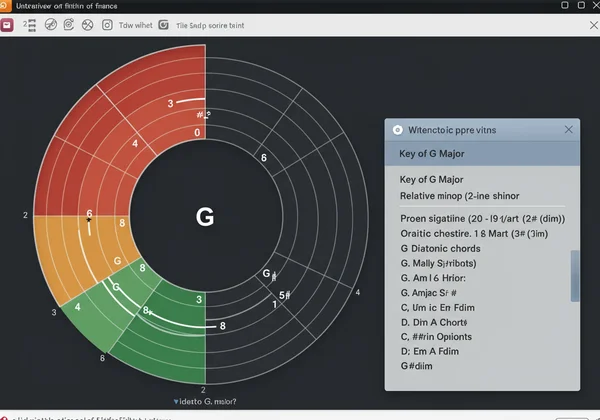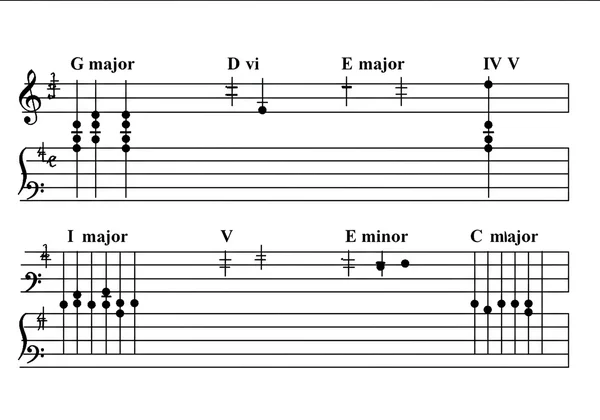Harmonize a Melody: Step-by-Step with the Circle of Fifths
Ever caught a melody in your head, so captivating it demands to be a song? You've got the spark, but then comes the challenge: finding the chords that give it life. For countless musicians and songwriters, harmonizing a melody can feel like hitting a wall – where does one even begin with music theory? What if you had an intuitive guide, a vibrant map to unlock those perfect harmonies? That map exists, and it's called the circle of fifths.
Transforming that naked melody into a fully realized piece of music is a process of discovery, and our interactive tool is designed to be your guide. Forget memorizing complex rules from a textbook. We're going to walk you through a practical workflow to harmonize any melody using a powerful, intuitive approach. With our interactive music theory tool, you can turn theory into sound with a single click.

Your Songwriting Workflow: Starting with the Melody
Before we can find the right chords, we need to understand the melody itself. Every melody has a tonal center—a "home base" note where the tune feels most at rest. Identifying this is the first and most critical step in your songwriting workflow. This process isn't about complex analysis; it's about listening carefully to what your melody is already telling you.
Think of your melody as a story. It has a beginning, a middle, and an end. The final note that makes the story feel "complete" is often the key to unlocking its harmony.
Analyzing Your Melody to Discover its Key
The first task is to discover its key. Hum or play your melody several times. Which note does it seem to gravitate towards? If you were to end the song, which note would provide the most satisfying conclusion? This note is likely the tonic, or the root note of the key. For example, if your melody feels most resolved when it lands on a G, you are probably working in the key of G major or G minor. This simple act of listening gives you the most important clue for building your chords.
Identifying Key Characteristics and Potential Harmonic Directions
Once you have a potential tonic note, listen to the overall mood of the melody. Does it sound bright, happy, and uplifting? It's likely in a major key. Does it sound more somber, reflective, or melancholic? You’re probably in a minor key. This distinction is crucial because it determines the first set of chords you will use. Understanding these basic harmonic directions sets the stage for choosing chords that complement the emotional feel of your melodic line. This initial analysis doesn't need to be perfect; it's a starting point that our interactive circle will help you confirm and explore.
Find Chords for Your Melody Using the Interactive Circle of Fifths
Now that you have a likely key, it's time to let the tool do the heavy lifting. This is where theory becomes practice. The Circle of Fifths is a visual representation of all 12 musical keys, organized in a way that reveals their relationships. Our goal is to find chords for your melody efficiently and creatively, and the interactive circle makes this incredibly simple.
Instead of looking at a static chart, you’ll be using a dynamic tool that responds to your creative choices. Let’s dive in.
Locating Your Melody's Key on the Circle of Fifths
Navigate to the Circle of Fifths tool on our homepage. You will see a large, clear circle with the major keys on the outside and their relative minors on the inside. Based on your analysis, click on the key you identified. For example, if you believe your melody is in G major, simply click on "G" on the outer ring.
Instantly, the tool will highlight the key of G and display all the essential information you need. You'll see its key signature (one sharp), its relative minor (E minor), and, most importantly, the family of chords that naturally belong to that key. This one click removes all the guesswork.

Building Diatonic Chords: The Foundation of Your Harmony
Once you select a key, our tool automatically generates a table of its diatonic chords. These are the seven chords built from the scale of your chosen key. They are the bread and butter of western music and the safest, most reliable choices for harmonizing your melody.
For the key of G Major, you will see:
- G major (I)
- A minor (ii)
- B minor (iii)
- C major (IV)
- D major (V)
- E minor (vi)
- F# diminished (vii°)
These seven chords are your primary palette. The Roman numerals (I, ii, V, etc.) describe the chord's function within the key. Start by playing these chords on your instrument while humming your melody. You'll quickly discover which ones fit best under certain notes. You can even click on each chord in the tool to hear it, helping you connect the theory directly to the sound.
Experimenting with Chord Progressions: A Live Demo
With your chord palette ready, you can start building progressions. The most powerful chords in any key are the tonic (I), the subdominant (IV), and the dominant (V). In G major, these are G, C, and D. Try moving between these three chords. You’ll be amazed at how many famous songs use only these three.
From there, introduce the minor chords, especially the incredibly versatile relative minor (vi), which is E minor in this case. The I-V-vi-IV progression (G - D - Em - C) is a certified hit-maker. The beauty of the online circle tool is that it lays these chords out for you, inviting you to experiment and discover new combinations that breathe life into your melody.

Elevate Your Music Composition: Advanced Harmonization Techniques
Once you are comfortable with the basics, the Circle of Fifths can help you unlock more advanced and emotionally resonant harmonies. A great music composition tutorial doesn't just stop at the fundamentals. It shows you how to add color, tension, and surprise to your music. Our tool is designed to help you visualize these more complex relationships as well.
Your goal is to move beyond predictable patterns and craft a harmonic journey that is uniquely your own.
Exploring Chord Substitutions and Borrowed Chords with Ease
The circle is organized by perfect fifths, which means adjacent keys share many of the same chords. This makes it easy to find compelling chord substitutions. For example, the keys of C and G are next to G Major on the circle. You can "borrow" a chord from one of them to add a fresh, unexpected sound to your progression. This technique can create beautiful moments of tension and release. The visual layout of the circle makes it intuitive to see which keys are closely related and are therefore great sources for borrowed chords.

Adding Embellishments and Voicings for Richer Harmony
While our tool provides the foundational triads, your creativity doesn't have to stop there. You can enrich your harmony by adding embellishments. Try turning your major and minor chords into 7th chords (e.g., turning G major into Gmaj7 or D major into D7). These additions add a layer of sophistication and emotional depth. The Circle of Fifths provides the correct harmonic framework, giving you a solid foundation upon which you can build these richer voicings and textures, confident that they will work within your song's structure. It's the perfect launchpad for more advanced [music composition].
From that initial spark of melody, you're now equipped to build a complete, vibrant song! By leveraging this straightforward workflow – analyzing your melody, exploring diatonic chords with our interactive tool, and experimenting with progressions – you've seamlessly connected your creative vision to concrete musical reality. You've seen how the Circle of Fifths is not just a dry theoretical diagram but a dynamic partner in your creative process.
The journey of a songwriter is one of constant learning and discovery. Don't let music theory be a barrier. Instead, use a tool that makes it an accessible and exciting part of your craft. Your next great song is waiting. It’s time to give it the harmony it deserves.
Ready to bring your melodies to life? Visit CircleOfFifths.io today and start harmonizing in seconds.
Your Questions About Melody Harmonization and the Circle of Fifths Answered
How can I use the Circle of Fifths to find the key of a song?
To find a song's key, first identify the note that feels like "home" (the tonic). Then, note which sharps or flats are consistently used in the melody. You can then look at the Circle of Fifths to see which key signature matches those sharps or flats. Our tool makes this easy by allowing you to visualize key signatures for every key with a single click.
What is the Circle of Fifths used for in songwriting?
In songwriting, the Circle of Fifths is a versatile tool used for multiple purposes. Its primary uses are: harmonizing melodies by identifying the diatonic chords in a key, creating compelling chord progressions, modulating smoothly between different keys, and understanding the relationships between keys to find creative chord substitutions.
Can the Circle of Fifths help me find chords for any melody?
Yes, for any melody that has a clear tonal center (meaning it's in a specific key), the Circle of Fifths is an exceptionally effective tool for finding the appropriate diatonic chords. While it may be less applicable to atonal or highly chromatic music, it is the perfect resource for the vast majority of music, from pop and rock to classical and jazz.
How do I memorize the Circle of Fifths for faster harmonization?
While memorization can be helpful, the best way to internalize the Circle of Fifths is through consistent use. Instead of relying on rote memorization techniques, make a habit of using an interactive tool every time you write. By repeatedly using our free tool to find keys and build progressions, you will naturally absorb the relationships and patterns until they become second nature.